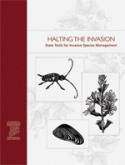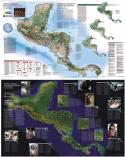
Research Reports
ELI publishes Research Reports available for free download that present the analysis and conclusions of the policy studies ELI undertakes to improve environmental law and policy. These reports contribute to education of the profession and disseminate diverse points of view and opinions to stimulate a robust and creative exchange of ideas. Those publications, which express opinions of the authors and not necessarily those of the Institute, its Board of Directors, or funding organizations, exemplify ELI’s commitment to dialogue with all sectors.
Non-native invasive species significantly threaten the ecological integrity of our nation`s natural systems. They displace native plants and animals, disrupt ecological processes, upset the stability of our ecosystems, and can permanently change our natural landscapes. Even though many invasive species are not regulated or controlled federally, states have passed a wide array of laws designed to address invasive species problems.
Read More >
Countless independent studies have concluded that communities of color and low-income communities are disproportionately exposed to environmental harms and risks. This handbook has been written with these unique environmental justice concerns in mind. It highlights sections of environmental laws that can be used to support and help advance your environmental justice goals.
Read More >
This report focuses on indoor air quality (IAQ), a key component of a healthy school environment. Indoor air quality has been ranked near the top of environmental risks in a number of government studies. See, e.g., EPA Science Advisory Board, "Reducing Risk: Setting Priorities and Strategies for Environmental Protection" (1990), available at http://www.epa.gov/opperspd/history7/reduce/toc.htm (last visited Jan. 8, 2002).
Read More >
In 2001, Native Lands published this detailed case study/manual of the participatory mapping it jointly organized in Honduras, Panama, and Bolivia.
This is a detailed account and analysis of the road Native Lands followed to devise and fine-tune the methodology it has been using since 1992. The narrative takes the reader from imperfect, sometimes confused beginnings to a much surer sense of what works and what does not, how community participation can be maximized, what to eliminate, and what to add, strengthen, and bring into focus.
Read More >
In January of this year Native Lands’ new map, Indigenous Peoples and Natural Ecosystems in Central America and Southern Mexico, was completed. It is an update of an earlier map, The Coexistence of Indigenous Peoples and the Natural Environment in Central America, published in 1992. Both maps were collaborative efforts between Native Lands and the National Geographic Society. The original map put on display forest cover and areas of indigenous use and occupation.
Read More >